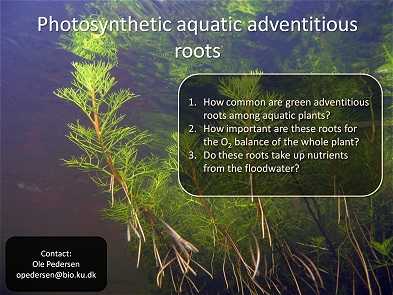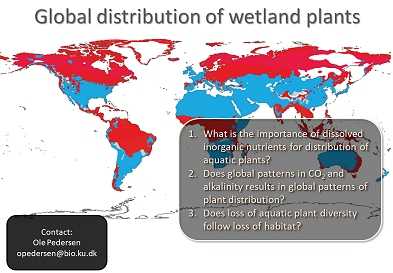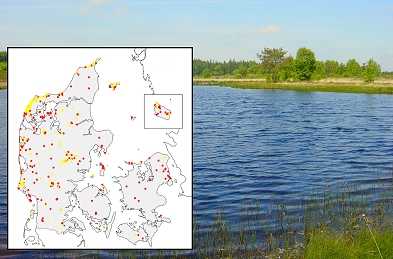Student research projects are offered as BSc and MSc thesis project as well as individual projects at bachelor or candidate level. Most project are suitable both as individual projects or for collaborative work in groups from 2-4. If you choose a topic under my supervision, you will be part of a dynamic team of BSc, MSc and PhD students as well as postdocs, and with an opportunity to plan part of your research in laboratories abroad (e.g., the Netherlands, Italy, Japan or Australia) where we have a strong track record of fruitful collaboration. The topics below are for inspiration only (see also menu item RESEARCH TOPICS) - they can all be tailored to suit your personal interests. You are also most welcome to contact me if you have ideas of your own that you would like to pursue.
Flood tolerance of wetland plants
Climate changes have already resulted in an increased number of flood events also in parts of the world where the annual precipitation has decrease. Hence, the natural vegetation of wetlands becomes flooded on a stochastic basis and the plants have to cope with the flooded - or perish. Also dryland vegetation, including many of our important crops, may become flooded with severe consequences for natural ecosystems and crops yields. Plants have evolved traits conferring flood tolerance and the aim of the project is to work with these traits in order to better understand how natural wetland plants respond to flooding. This research may lead to breeding of crops such as rice, wheat and barley that are better suited to a modern climate.
See the list of publications for articles on this exciting topic!
Contact Ole Pedersen for more information.
Brownification of lobelia lakes
Scandinavian lobelia lakes become increasingly more humic with dramatic consequences for the biodiversity of pristine ecosystems as the water turns brown. It is not known why the brownification has accelerated in recent years and it may be due to a combination of factors such as warming, increased productivity in the catcment area, increase precipitation and increasing pH in the terrestrial soils. The project can deal with single lakes where sources of brownification can be identified, or the project can use a large-scale approach using GIS in order to understand the extend of the problem.
See the list of publications for articles on this exciting topic!
Contact Ole Pedersen for more information; these projects are co-supervised by Theis Kragh.
Tissue tolerance to anoxia or hyperoxia
Oxygen is toxic so living cells protect themselves from free radicals by means of antioxidants. On the other hand, oxygen is also needed for aerobic respiration and thus a fine regulation of oxygen is needed. However under water, oxygen has a tendency to accumulate to extremely high levels in the light due to oxygen produced in photosynthesis, whereas it declines to critically low levels during night due to aerobic respiration. It is not known how aquatic plants handle these dramatic fluctuations in oxygen over a diurnal cycle with too much during the day and too little during the night. The project is experimental and involves use of high-tech oxygen microsensors and can be carried out on seagrasses or marcroalgae.
See the list of publications for articles on this exciting topic!
Contact Ole Pedersen for more information; this project is co-supervised by Jens Borum
Inorganic carbon use in a climate scenario
The sea absorbs the majority of the CO2 which is released to the atmosphere by burning of fossil fuels. Hence, pH of seawater is declining and CO2 is increasing. We do not know how this impacts upon inorganic carbon use by photosynthetic organisms in the sea such as seagrasses (rooted flowering plants), macroalgae or phytoplankton. The project is likely to use an experimental approach to reveal the exciting mechanisms involved in acclimation to increasing CO2 in the sea.
See the list of publications for articles on this exciting topic!
Contact Ole Pedersen for more information.
Photosynthetic aquatic adventitious roots
Many wetland plants produce adventitious roots as a response to flooding since the primary root system often dies in waterlogged soils. The roots emerge from the stem and some are hanging freely in water column - with time, these turn green and become photosynthetic. It is not known how common this phenomenon is and if it is of any quantitative importance for the plant. The project is suitable for detailed mechanistic studies on few model species or for a more descriptive screening approach using several plant species.
See the list of publications for articles on this exciting topic!
Contact Ole Pedersen for more information.
Global patterns in...
Wetland plants, including truly aquatic plants, possess traits that enable them to grow and reproduce in water. Like terrestrial plants, wetland plants respond to environmental parameters such as light, nutrients and water chemistry. It is not known how water chemistry (dissolved inorganic carbon and nutrients) influences plant distribution both on regional or global scales. The projects use international (or national) databases with information on plant occurrence, water chemistry and type of water body in combination with GIS analyses to predict plant distribution on environmental or climatic gradients.
See the list of publications for articles on this exciting topic!
Contact Ole Pedersen for more information; these projects are co-supervised by Anders Winkel, Lars Båstrup-Spohr and Lars Iversen.
National patterns in...
We have access to unique data on distribution of the threatened isoetids (Lobelia dortmanna, Littorella uniflora, Isoetes lacustris and I. echinospora) in relation to key water chemistry parameters (alkalinity, pH, TN, TP, colour and much more). Surprisingly, nobody has yet analyzed these data using a GIS approach where these are paired with information on soil type and land use. This is an ideal project at both bachelor and master level and it can be combined with exciting field work as some of the water chemistry data likely need to be supplemented to fill in some gaps in the current data set.
See the list of publications for articles on this exciting topic!
Contact Ole Pedersen for more infomration.








